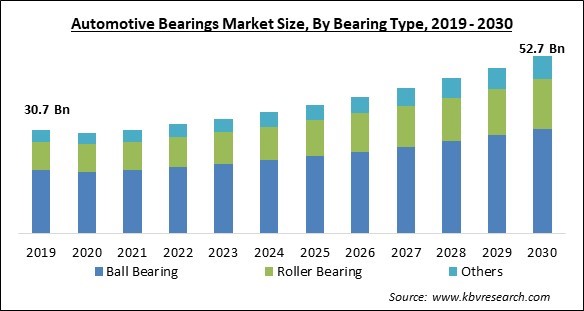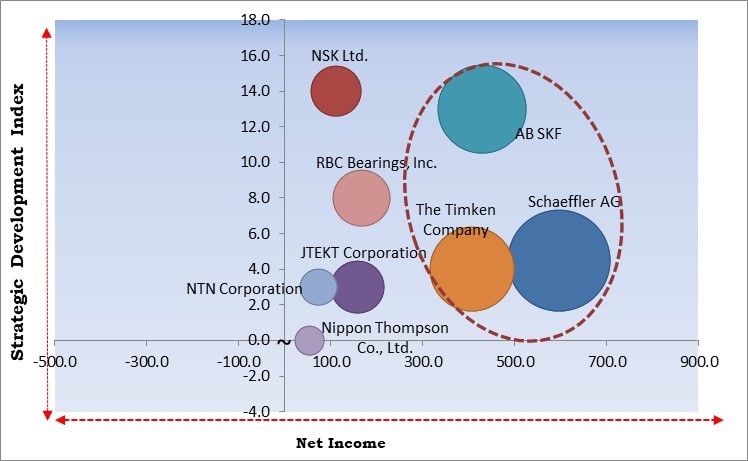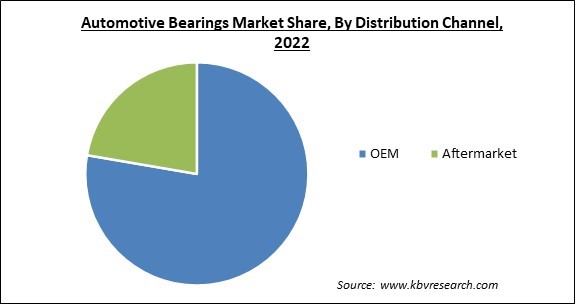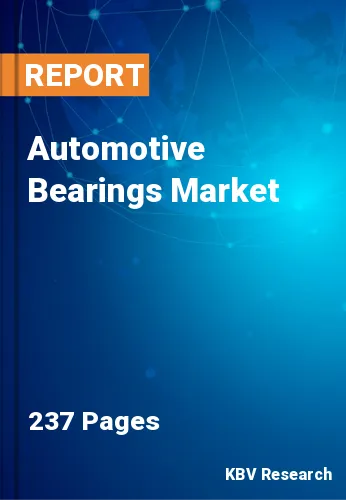The Global Automotive Bearings Market size is expected to reach $52.7 billion by 2030, rising at a market growth of 6.4% CAGR during the forecast period.
Utilizing sophisticated bearing materials, such as chromium steel, in high-precision ball bearings increases the product's hardness, wear resistance, and fatigue life. Therefore, Ball Bearing Segment is expected to capture more than 59% share by 2030. Complex bearing components can be produced lightweight and cost-effectively using additive manufacturing. Using tungsten carbide improves stress and impact resistance, requiring less lubrication to function effectively under high-temperature conditions. In addition, lightweight bearings can be designed with 3D printing, which would be challenging and time-consuming with conventional manufacturing technology.

The major strategies followed by the market participants are Acquisitions as the key developmental strategy in order to keep pace with the changing demands of end users. In January, 2022, SKF took over Laser Cladding Venture to enable a circular economy approach that sustains SKF's ambition to deliver solutions that reduce the entire CO2 footprint. Additionally, In January, 2022, NSK took over Alliance Bearing Repair and Reclaim to improve its service and support capabilities to effectively handle bearing life cycle expenses for consumers.
Based on the Analysis presented in the KBV Cardinal matrix; The Timken Company, Schaeffler AG, and AB SKF are the forerunners in the Market. In November, 2022, The Timken Company acquired GGB Bearings. This acquisition supports several diverse clients, markets, locations, and applications. The GGB Bearings tribology coatings for plain bearings complement Timken's industry-leading positions in ball and roller bearings. Companies such as JTEKT Corporation, NSK Ltd. are some of the key innovators in the Market.

Population growth has also contributed to an increase in the demand for transportation. Increased disposable income due to economic growth in several countries has fueled an upsurge in automobile demand. In addition, as more people move to urban areas, the automobile market expands. The rise of the automobile industry in developing nations over the past few decades has been fueled by government regulations mandating high levels of safety and local content. Consequently, the rising demand and production of bearings are anticipated to support the expansion of the market.
In an effort to enhance performance, the latest trend among automotive industry suppliers is the incorporation of sensor units into bearings. In automotive wheel applications, sensor bearings are the most prevalent. Most automotive hub unit bearings include speed sensors that transmit wheel speed information to the anti-lock brake system (ABS) and traction control modules of two-wheelers and light vehicles. Moreover, sensor-bearing units digitally monitor rotational speed, axial movement, acceleration, deceleration, and cargo-carrying capacity in passenger and commercial vehicles.
The cost of raw materials remains the manufacturers' primary concern. The majority of a bearings manufacturer's revenue comes from raw materials. The cost of primary materials for automotive bearings fluctuates continuously in response to market conditions. In addition, bearings require routine maintenance to prevent failure and extend their service life, increasing maintenance costs. Consequently, factors that include fluctuating raw material prices and regular maintenance costs restrain the expansion of the market over the forecast period.
By distribution channel, the market is classified into OEM and aftermarket. In 2022, the aftermarket segment covered a considerable revenue share in the market. The market's growth is fuelled by factors such as the increasing demand for aftermarket repair and maintenance services, as the average age of vehicles continues to rise as consumers hold on to their vehicles for extended periods. The vehicles may experience issues as they age and will need periodic maintenance, including the replacement of several spare parts, like bearings.

Based on bearing type, the market is segmented into ball bearings, roller bearings, and others. In 2022, the ball bearings segment held the highest revenue share in the market. This results from product innovations and extensive R&D efforts that have led to the development of various integrated and advanced sensor ball-bearing units. The companies are creating hybrid ball bearings (DGBB) with steel rings and ceramic rolling elements. The bearings provide enhanced high-speed performance as well as superior electrical insulation.
On the basis of vehicle type, the market is fragmented into passenger car, commercial vehicle, and two-wheeler. In 2022, the passenger car segment witnessed the largest revenue share in the market. Manufacturers typically employ two transmission bearing units: free-end bearing and fixed-end bearing units. Passenger cars also utilize needle bearings or needle roller transmission bearings as these vehicles are designed to transport minimal burdens compared to commercial vehicles. As these bearings can be assembled directly in the ground, the passenger car segment of the market is expanding.
| Report Attribute | Details |
|---|---|
| Market size value in 2022 | USD 32.4 Billion |
| Market size forecast in 2030 | USD 52.7 Billion |
| Base Year | 2022 |
| Historical Period | 2019 to 2021 |
| Forecast Period | 2023 to 2030 |
| Revenue Growth Rate | CAGR of 6.4% from 2023 to 2030 |
| Number of Pages | 237 |
| Number of Table | 344 |
| Report coverage | Market Trends, Revenue Estimation and Forecast, Segmentation Analysis, Regional and Country Breakdown, Competitive Landscape, Companies Strategic Developments, Company Profiling |
| Segments covered | Bearing Type, Distribution Channel, Vehicle Type, Region |
| Country scope | US, Canada, Mexico, Germany, UK, France, Russia, Spain, Italy, China, Japan, India, South Korea, Singapore, Malaysia, Brazil, Argentina, UAE, Saudi Arabia, South Africa, Nigeria |
| Growth Drivers |
|
| Restraints |
|
Region wise, the market is analyzed into North America, Europe, Asia-Pacific, and LAMEA. In 2022, the Asia-Pacific region generated the maximum revenue share in the market. The Asia-Pacific market is propelled by the rising demand for automobiles resulting from rising disposable incomes, a growing population, and accelerated urbanization in the region. Over the forecast period, the increasing demand for passenger vehicles in countries such as India, China, and others will likely boost demand for automotive bearings. In addition, the expansion of major automakers, such as Hyundai, Kia, Tata, Mitsubishi, and Toyota, among others, in multiple parts of the continent is likely to benefit the market.
Free Valuable Insights: Global Automotive Bearings Market size to reach USD 52.7 Billion by 2030
The market research report covers the analysis of key stake holders of the market. Key companies profiled in the report include JTEKT Corporation, AB SKF, Schaeffler AG, NSK Ltd., NTN Corporation, The Timken Company, Nippon Thompson Co., Ltd., RBC Bearings, Inc., Iljin Group, and Cixing Group Co., Ltd.
By Bearing Type
By Distribution Channel
By Vehicle Type
By Geography
The Market size is projected to reach USD 52.7 billion by 2030.
Introduction of Sensor-Bearing Devices are driving the Market in coming years, however,Fluctuating Costs of Raw Materials and High Maintenance restraints the growth of the Market.
JTEKT Corporation, AB SKF, Schaeffler AG, NSK Ltd., NTN Corporation, The Timken Company, Nippon Thompson Co., Ltd., RBC Bearings, Inc., Iljin Group, and Cixing Group Co., Ltd.
The OEM segment is leading the Market by Distribution Channel in 2022; thereby, achieving a market value of $38.9 billion by 2030.
The Asia Pacific region dominated the Market by Region in 2022, and would continue to be a dominant market till 2030; thereby, achieving a market value of $21.5 billion by 2030.
Our team of dedicated experts can provide you with attractive expansion opportunities for your business.

